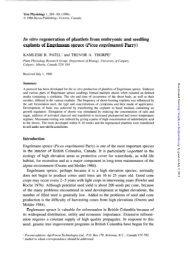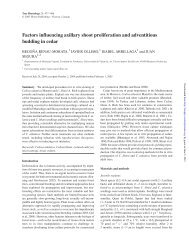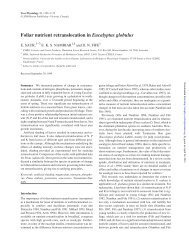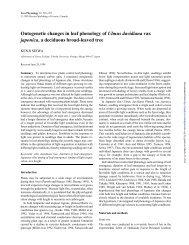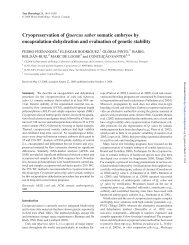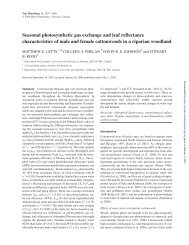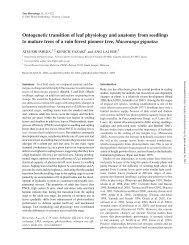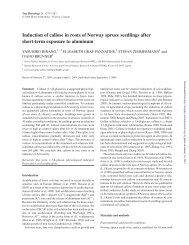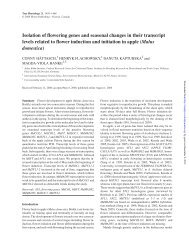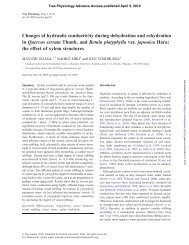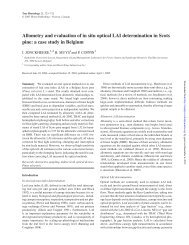Sucrose (JrSUT1) and hexose (JrHT1 and JrHT2 ... - Tree Physiology
Sucrose (JrSUT1) and hexose (JrHT1 and JrHT2 ... - Tree Physiology
Sucrose (JrSUT1) and hexose (JrHT1 and JrHT2 ... - Tree Physiology
You also want an ePaper? Increase the reach of your titles
YUMPU automatically turns print PDFs into web optimized ePapers that Google loves.
SUCROSE AND HEXOSE TRANSPORTERS IN WALNUT XYLEM PARENCHYMA 217<br />
the perfused vessels with nitrogen gas. The solution was collected<br />
for measurement of 14 C/ 3 H ratio at equilibrium <strong>and</strong> the<br />
bud immediately frozen in liquid nitrogen <strong>and</strong> stored at –20 °C<br />
until lyophilized, ground <strong>and</strong> the sugar extracted <strong>and</strong> its radioactivity<br />
determined.<br />
The sugar content of cells of vegetative buds was obtained<br />
by correcting the total 14 C radioactivity in the bud by the<br />
apoplasmic 14 C radioactivity ( 14 C cells = total 14 C– 14 C apoplasm,<br />
where 14 C apoplasm = ( 14 C/ 3 H)( 3 H in vegetative bud)).<br />
Total RNA extraction, <strong>and</strong> construction <strong>and</strong> screening of a<br />
xylem-derived cDNA library<br />
Total RNA was extracted from xylem, bark, source leaf, fine<br />
root <strong>and</strong> flowers (male <strong>and</strong> female) as described by Gévaudant<br />
et al. (1999). The RNA was quantified spectrophotometrically<br />
<strong>and</strong> its quality assessed by gel electrophoresis.<br />
A xylem <strong>hexose</strong> transporter probe was obtained by reverse<br />
transcription polymerase chain reaction (RT-PCR). Reverse<br />
transcription was carried out with 1 µg of total RNA extracted<br />
from xylem tissue in May <strong>and</strong> the Ready To Go T-primed<br />
First-Str<strong>and</strong> kit (Amersham). For the PCR, the following degenerate<br />
primers were used: Hex1, 5′-G(C/T)(T/G/C)AT-<br />
(T/C)ATGTT(C/T)TA(C/T)GC(A/C/G)CCTGT-3′; <strong>and</strong><br />
Hex2, 5′-CCA(T/A)ACTT(C/G)A(T/A)(A/C/G)CT(G/C)-<br />
(A/C)CA(C/A)(C/A)AGCAT-3′; which were deduced from<br />
conserved regions of plant <strong>hexose</strong> transporter cDNAs (EMBL<br />
data library).<br />
Amplification was carried out in a thermal cycler (Gene<br />
Amp PCR system, Perkin Elmer) according to st<strong>and</strong>ard protocols.<br />
The amplified fragment (460 bp) was sequenced <strong>and</strong><br />
used as a <strong>hexose</strong> transporter homologous probe to screen a xylem<br />
cDNA library (Sakr et al. 2003) under low stringency conditions.<br />
Two clones were obtained, completely sequenced <strong>and</strong><br />
named <strong>JrHT1</strong> <strong>and</strong> <strong>JrHT2</strong> for Juglans regia <strong>hexose</strong> transporter<br />
1 <strong>and</strong> 2, respectively. The sequences of <strong>JrHT1</strong> <strong>and</strong> <strong>JrHT2</strong> have<br />
EMBL/Genbank/DDBJ Accession nos. DQ026508 <strong>and</strong><br />
DQ026509, respectively.<br />
Semi-quantitative RT-PCR<br />
One µg of total RNA, extracted from xylem tissues as described<br />
above, was reverse transcribed. Three µl of the synthesized<br />
first-str<strong>and</strong> cDNA was amplified by PCR. Amplification<br />
of <strong>JrHT1</strong> <strong>and</strong> <strong>JrHT2</strong>, <strong>JrSUT1</strong> <strong>and</strong> JrAct (J. regia actin) was<br />
performed with the following specific primers: Hex11 (sense),<br />
5′-AGGAGATGAACAGAGTATGGAAGACC-3′ <strong>and</strong> Hex12<br />
(antisense), 5′-AGGHAAAACTAAAGAGCAAGGTCCC-3′<br />
for the amplification of <strong>JrHT1</strong> <strong>and</strong> <strong>JrHT2</strong>; Sut11 (sense),<br />
5′-AGATGCAATATCCGCAGTTCCC-3′ <strong>and</strong> Sut12 (antisense),<br />
5′-GCATGGHCTTTTGTAGCATTGGG-3′, for the<br />
amplification of <strong>JrSUT1</strong>; Act11 (sense), 5′-GATGAAGCCC-<br />
AATCAAAGAGGGGT-3′ <strong>and</strong> Act12 (antisense) <strong>and</strong> 5′-TGT-<br />
CCATCACCAGAAATCCAGCAC-3′ for the amplification of<br />
JrAct; JrEF1A (sense), 5′-TGG(A/T/C)GG(A/T)ATTGA-<br />
(T/C)AAGCGTG-3′ <strong>and</strong> JrEF1B (antisense), 5′-CAAT-<br />
(T/C)TTGTA(A/G)ACATCCTGAAG-3′ for the amplification<br />
of JrEF1 (J. regia Elongation Factor 1 alpha). Each PCR<br />
TREE PHYSIOLOGY ONLINE at http://heronpublishing.com<br />
was carried out as follows: 2 min at 94 °C for denaturation,<br />
20 s at 94 °C, 20 s at 59 °C <strong>and</strong> 45 s at 72 °C for 35 (<strong>JrHT1</strong>,<br />
<strong>JrHT2</strong> <strong>and</strong> <strong>JrSUT1</strong>), <strong>and</strong> 25 cycles (JrAct) followed by 10 min<br />
at 72 °C for the final extension. The amplification of JrEF1<br />
was carried out as follows: 2 min at 94 °C for denaturation,<br />
20 s at 94 °C, 30 s at 57 °C <strong>and</strong> 45 s at 72 °C, for 35 cycles. The<br />
optimal numbers of PCR cycles were established to generate<br />
unsaturated (linear phase) but detectable signals. All PCRs<br />
were performed in parallel on the same cDNA under the same<br />
conditions.<br />
Preparation of the affinity-purified anti-JrHTs antibody<br />
Anti-<strong>JrHT1</strong> <strong>and</strong> anti-<strong>JrHT2</strong> antiserum was raised in rabbits<br />
(Eurogentec, Herstal, Belgium) against a synthetic peptide<br />
(PKVEMGKGGRAIKNV) coupled to a carrier protein<br />
(KLH). This sequence was derived from the C-terminal region<br />
of <strong>JrHT1</strong> <strong>and</strong> <strong>JrHT2</strong>, but is not conserved in all <strong>hexose</strong> transporters<br />
from other species. Antibodies were affinity-purified<br />
against the synthetic peptide <strong>and</strong> checked for cross-reaction<br />
against the C-terminal region of <strong>JrHT1</strong>. The proteins cross-reacting<br />
with anti-<strong>JrHT1</strong> <strong>and</strong> anti-<strong>JrHT2</strong> antibodies are called<br />
<strong>JrHT1</strong> <strong>and</strong> <strong>JrHT2</strong>.<br />
The affinity-purified anti-<strong>JrSUT1</strong> antibody was raised<br />
against a synthetic peptide (MEVESANKDMRAAQR) chosen<br />
from the N-terminal region of <strong>JrSUT1</strong> (Decourteix et al.<br />
2006). As in Decourteix et al. (2006), the proteins cross-reacting<br />
with anti-<strong>JrSUT1</strong> antibody are called <strong>JrSUT1</strong>.<br />
Microsomal fraction <strong>and</strong> analysis by SDS-PAGE <strong>and</strong><br />
Western blot<br />
Xylem microsomal fractions from the apical <strong>and</strong> basal segments<br />
of the sample shoots were isolated as described by<br />
Alves et al. (2004). Protein samples (30 µg) were subjected to<br />
sodium dodecyl sulfate polyacrylamide gel electrophoresis<br />
(SDS-PAGE) according to Laemmli (1970). The gel system<br />
consisted of a 5% stacking gel <strong>and</strong> a 10% resolving gel. After<br />
electrophoresis, polypeptides were transferred to a nitrocellulose<br />
membrane (Transfer Membrane, BioTrace NT) by<br />
electroblotting. Membranes were probed with either anti-<br />
<strong>JrHT1</strong> <strong>and</strong> anti-<strong>JrHT2</strong> (1/500 dilution) or anti-<strong>JrSUT1</strong><br />
(1/3000 dilution) primary antibodies <strong>and</strong> anti-rabbit IgG<br />
(H + L) (P.A.R.I.S., Compiègne, France) peroxidase-labeled<br />
secondary antibody (1/10,000 dilution). The protein–antibody<br />
complex was detected with the ECL Western blotting<br />
analysis system (Amersham Pharmacia Biotech).<br />
<strong>JrSUT1</strong>, <strong>JrHT1</strong> <strong>and</strong> <strong>JrHT2</strong> immunolocalization in xylem<br />
parenchyma cells<br />
Immunolocalization of <strong>JrSUT1</strong> <strong>and</strong> <strong>JrHT1</strong> <strong>and</strong> <strong>JrHT2</strong> was<br />
performed on apical <strong>and</strong> basal segments of 1-year old stems as<br />
described by Decourteix et al. (2006). Briefly, each stem segment<br />
of about 4 mm in length was fixed for 45 min at 4 °C in<br />
1.5% (v/v) formaldehyde <strong>and</strong> 0.5% (v/v) glutaraldehyde in<br />
0.1 M phosphate buffer (pH 7.4) containing 0.5 % (v/v) dimethylsulfoxide<br />
<strong>and</strong> then washed in 0.1 M phosphate buffer<br />
(pH 7.4) followed by phosphate buffered saline (PBS, pH 7.2).<br />
Downloaded from<br />
http://treephys.oxfordjournals.org/ by guest on December 27, 2012



